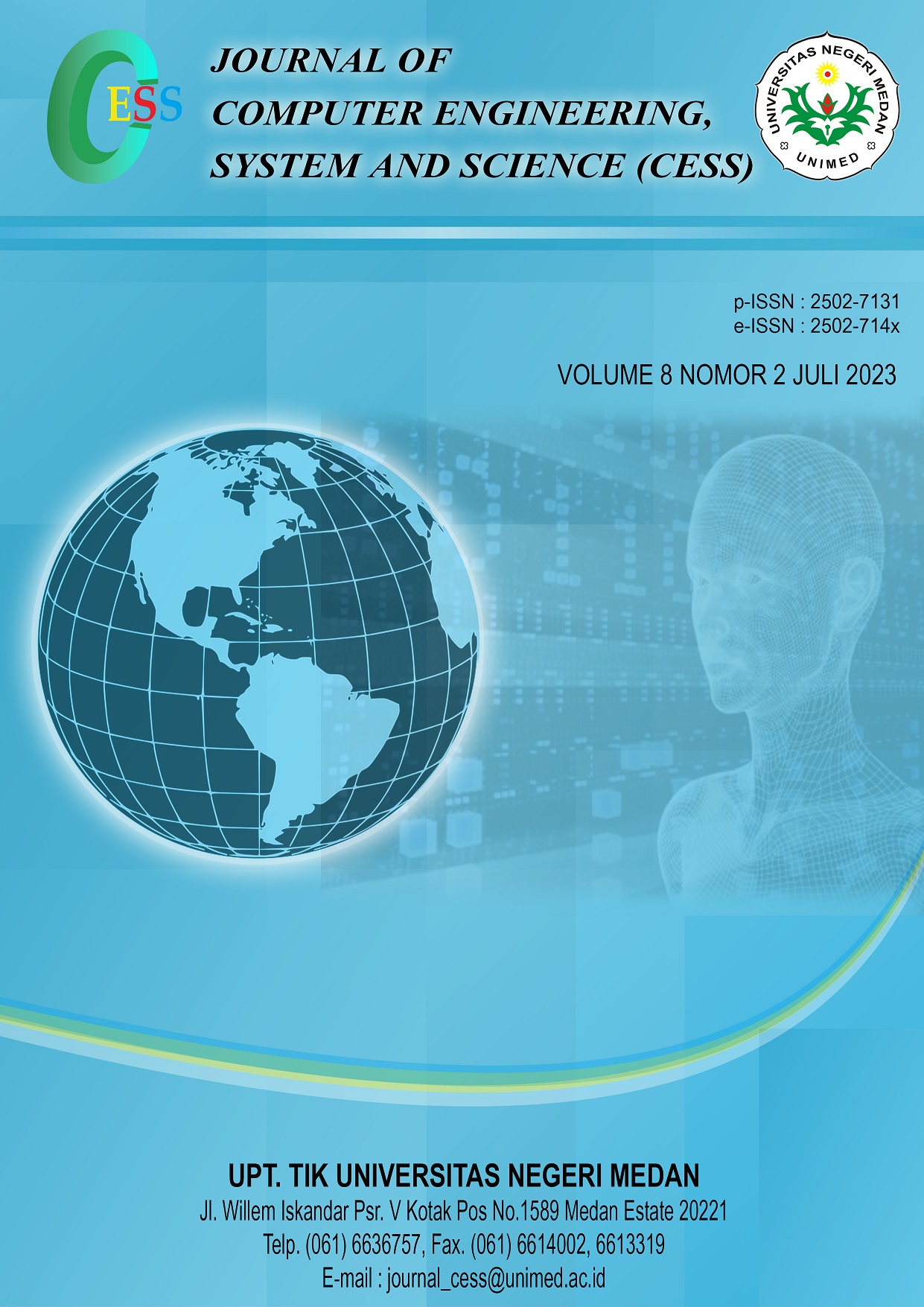Fever Classification Using the Neighbor Weighted K-Nearest Neighbor Method
DOI:
https://doi.org/10.24114/cess.v8i2.43267Keywords:
Fever, DHF, Malaria, Typhoid Fever, Neighbor Weighted K-Nearest NeighborAbstract
Demam merupakan gejala atau reaksi tubuh terhadap suatu infeksi atau penyakit. Demam dapat disebabkan karena adanya infeksi virus, bakteri, dan parasit. Serta demam akibat gigitan nyamuk. Beberapa penyakit penyebab demam yang perlu diwaspadai antara lain Demam Berdarah Dengue (DBD), Demam Tifoid, dan Malaria dikarenakan gejala klinis dari ketiga penyakit tersebut sangat mirip dan sulit untuk dibedakan. Akibat dari gejala yang mirip, seringkali menyebabkan kesulitan dalam mendapatkan diagnosis awal sehingga kurang tepat dalam penanganan. Oleh karena itu, pada penelitian ini dibangun sebuah sistem yang dapat mengklasifikasikan demam menggunakan metode Neighbor Weighted K-Nearest Neighbor. Data yang digunakan berjumlah 300 data dengan komposisi rasio data latih dan data uji sebesar 70%:30% sehingga data latih yang digunakan berjumlah 210 data dan data uji berjumlah 90 data. Penelitian ini dilakukan dengan mengamati variasi nilai ketetanggaan (K) dan nilai exp (E) terhadap akurasi sistem klasifikasi demam. Hasil pelatihan menunjukkan bahwa nilai K dan E yang bervariasi tidak mempunyai pengaruh terhadap akurasi tersebut. Hasil pengujian yang dilakukan mendapatkan akurasi sebesar 100% pada setiap variasi nilai K dan E.Fever is a symptom of the body's reaction to an infection or disease. Fever can be caused by viral, bacterial, or parasitic infections. as well as fever due to mosquito bites. Several diseases that cause fever that need to be watched out for include dengue hemorrhagic fever (DHF), typhoid fever, and malaria because the clinical symptoms of these three diseases are very similar and difficult to distinguish. As a result of similar symptoms, it often causes difficulties in getting an early diagnosis, so treatment is not appropriate. Therefore, in this study, a system was developed that could classify fever using the neighbor weighted K-nearest neighbor method. The data used totaled 300, with a composition ratio of 70% training data to 30% test data, for a total of 210 training data and 90 test data. This research was conducted by observing the variation in the value of neighborliness (K) and the value of exp (E) on the accuracy of the fever classification system. The results of the training show that the varying K and E values have no effect on accuracy. The results of the tests carried out obtained an accuracy of 100% for each variation in the values of K and E.Downloads
References
Halodoc, œDemam - Gejala, Penyebab, dan Pengobatan, Halodoc, 2022. https://www.halodoc.com/kesehatan/demam (diakses 27 Juli 2022).
Y. Levani dan A. D. Prasetya, œDemam tifoid : manifestasi klinis, pilihan terapi dan pandangan dalam islam, AL-IQRA Med. J. J. Berk. Ilm. Kedokt., vol. 3, no. 1, hal. 10“16, 2020.
Kementerian Kesehatan RI, Profil Kesehatan Indonesia Tahun 2011. Jakarta: Kementerian Kesehatan RI, 2012.
Kementerian Kesehatan RI, œBuletin Jendela Epidemiologi Demam Berdarah Dengue, Buletin Jendela Epidemiologi, vol. 2, Jakarta, 2010.
Kementerian Kesehatan RI, Profil Kesehatan Indonesia 2020. Jakarta: Kementerian Kesehatan RI, 2021.
Kementerian Kesehatan RI, Buku Saku Tatalaksana Kasus Malaria. Jakarta: Direktorat Jenderal Pencegahan dan Pengendalian Penyakit Kementerian Kesehatan Republik Indonesia, 2020.
D. Z. Maliha, E. Santoso, dan M. T. Furqon, œPenerapan Metode Neighbor Weighted K-Nearest Neighbor Dalam Klasifikasi Diabetes Mellitus, J. Pengemb. Teknol. Inf. dan Ilmu Komput., vol. 3, no. 3, hal. 2910“2915, 2019, [Daring]. Tersedia pada: https://j-ptiik.ub.ac.id/index.php/j-ptiik/article/view/4817
M. V. Rosyidah, B. D. Setiawan, dan M. T. Furqon, œDiagnosis Hama Penyakit Tanaman Bawang Merah Menggunakan Algoritma Neighbors Weighted K-Nearest Neighbors (NWKNN), J. Pengemb. Teknol. Inf. dan Ilmu Komput., vol. 3, no. Vol 3 No 3 (2019), hal. 404“415, 2019, [Daring]. Tersedia pada: https://j-ptiik.ub.ac.id/index.php/j-ptiik/article/view/4864/2271
E. N. Shofia, R. R. M. Putri, dan A. Arwan, œSistem Pakar Diagnosis Penyakit Demam : DBD , Malaria dan Tifoid Menggunakan Metode K-Nearest Neighbor “ Certainty Factor, J. Pengemb. Teknol. Inf. dan Ilmu Komput., vol. 1, no. 5, hal. 426“435, 2017.
D. T. Larose, Discovering Knowledge in Data: An Introduction to Data Mining: Second Edition, vol. 9780470908. Canada: John Wiley & Sons, Inc., Hoboken, New Jersey., 2005. doi: 10.1002/9781118874059.
S. Tan, œNeighbor-weighted K-nearest neighbor for unbalanced text corpus, Expert Syst. Appl., vol. 28, hal. 667“671, 2005, doi: 10.1016/j.eswa.2004.12.023.
P. N. Fadila, Indriati, dan D. E. Ratnawati, œIDENTIFIKASI JENIS ATTENTION DEFICIT HYPERACTIVITY DISORDER ( ADHD ) PADA ANAK USIA DINI MENGGUNAKAN METODE NEIGHBOR WEIGHTED K-NEAREST NEIGHBOR ( NWKNN ), J. Teknol. Inf. dan Ilmu Komput., vol. 3, no. 3, hal. 194“200, 2016.
Mustika dkk., DATA MINING DAN APLIKASINYA. Bandung: WIDINA BHAKTI PERSADA BANDUNG (GRUP CV. WIDINA MEDIA UTAMA), 2021.
B. Santoso, A. I. S. Azis, dan Zohrahayaty, Machine Learning & Reasoning Fuzzy Logic Algoritma, Manual, Matlab, & Rapid Miner. Yogyakarta: Penerbit DEEPUBLISH, 2020.
W. Setiawan, Topik Khusus Kecerdasan Komputasional: Deep Learning untuk Image dan Speech Recognition. Malang: Media Nusa Creative (MNC Publishing), 2020. [Daring]. Tersedia pada: https://www.google.co.id/books/edition/Topik_Khusus_Kecerdasan_Komputasional/A4ZOEAAAQBAJ?hl=id&gbpv=1&kptab=getbook
Downloads
Published
How to Cite
Issue
Section
License
Copyright (c) 2023 CESS (Journal of Computer Engineering, System and Science)

This work is licensed under a Creative Commons Attribution 4.0 International License.















